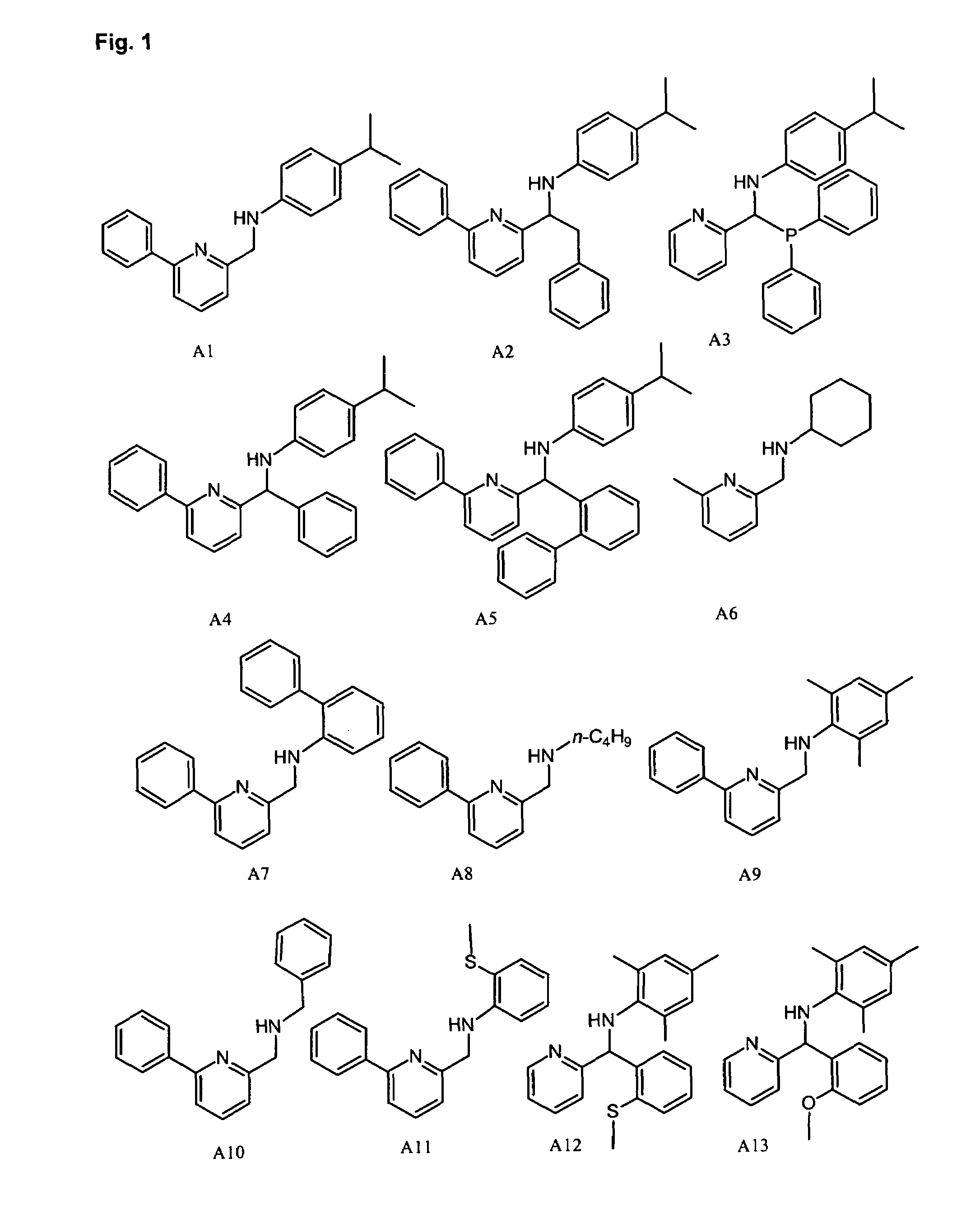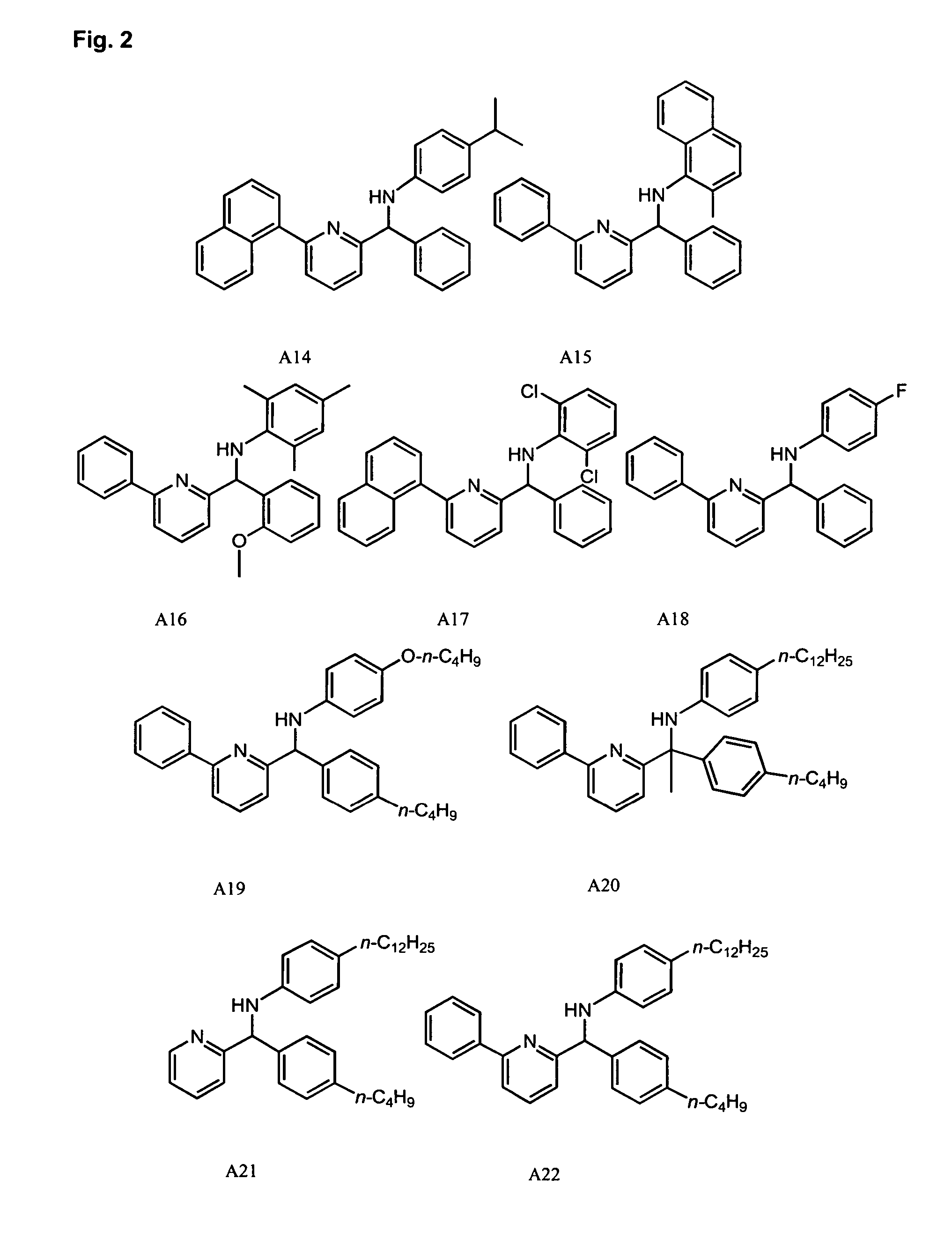Methods for oligomerizing olefins
- Summary
- Abstract
- Description
- Claims
- Application Information
AI Technical Summary
Benefits of technology
Problems solved by technology
Method used
Image
Examples
examples
[0234]General: All air sensitive procedures were performed under a purified argon or nitrogen atmosphere in a Vacuum Atmospheres or MBraun glove box. All solvents used were anhydrous, de-oxygenated and purified according to known techniques (see for example, D. D. Perrin & W. L. F. Armarego Purification of Laboratory Chemicals, 3rd Ed., (Pergamon Press: New York, 1988)). All ligands and metal precursors were prepared according to procedures known to those of skill in the art, e.g., under inert atmosphere conditions, etc. Ethylene oligomerization experiments were carried out in a parallel pressure reactor, described in U.S. Pat. Nos. 6,306,658, 6,455,316 and 6,489,168, and in U.S. application Ser. No. 09 / 177,170, filed Oct. 22, 1998, WO 00 / 09255, and a parallel batch reactor with in situ injection capability, as described in WO 04 / 060550, and U.S. Application No. 2004 / 0121448, each of which is incorporated herein by reference.
[0235]Quantitative analysis of the liquid olefin products ...
example a
Synthesis of Pyridyl-Amine Ligand A29: Example of Method A
Step 1
[0236]
[0237]To a solution of 23.7 g (100 mmol) of 2,6-dibromopyridine in 150 mL of anhydrous, degassed THF cooled to −78° C. was added dropwise under N2 a solution of 11.0 mL (110 mmol) of 10.0 M n-BuLi in 150 mL anhydrous, degassed Et2O. After 2 hours at −78° C., 24.2 mL (300 mmol) of anhydrous degassed DMF was added dropwise with rapid stirring. This solution was stirred at −78° C. for 2 hours, and was then allowed to warm to room temperature (RT) overnight. The solution was cooled to −78° C. and 100 mL of 1.0 M aq. HCl was added slowly. The organic phase was separated and the aqueous phase was washed with 3×50 mL Et2O. The organic washes were combined and washed with 3×50 mL H2O and 3×50 mL brine, then dried over Na2SO4. The volatiles were removed in vacuo to provide an orange oil. The oil was triturated with hexanes to give 2-bromo-6-formylpyridine as a pale orange solid that was washed with cold pentanes and dried ...
example 1b
Synthesis of Pyridyl-Amine Ligand A51: Example of Method B
Step 1
[0244]
[0245]6-Bromopyridine-2-carboxaldehyde (1.86 g, 10.0 mmol) and carbazole (1.84 g, 11 mmol) were combined in anhydrous 1,4-dioxane (40 mL) under inert atmosphere. Cesium carbonate (4.56 g, 14 mmol), xantphos (0.382 mg, 0.66 mmol) and Pd2(dba)3 (0.275 g, 0.3 mmol) were added to the reaction mixture. The reaction mixture was sealed and heated at 100° C. for 72 h. The reaction was then cooled to ambient temperature, diluted with EtOAc (150 mL) and was washed with brine (75 mL). The organic layer was separated and dried over Na2SO4. The mixture was filtered, and the material was adsorbed onto neutral alumina for alumina chromatography. The material was eluted using a gradient of 0-20% EtOAc in hexanes. Fractions containing the product were pooled and evaporated yielding a product mixture as a yellow solid (2.28 g). GC-MS and 1H NMR confirmed this mixture included the desired product and the starting carbazole. The mate...
PUM
| Property | Measurement | Unit |
|---|---|---|
| pressures | aaaaa | aaaaa |
| pressures | aaaaa | aaaaa |
| length×0 | aaaaa | aaaaa |
Abstract
Description
Claims
Application Information
 Login to View More
Login to View More - R&D
- Intellectual Property
- Life Sciences
- Materials
- Tech Scout
- Unparalleled Data Quality
- Higher Quality Content
- 60% Fewer Hallucinations
Browse by: Latest US Patents, China's latest patents, Technical Efficacy Thesaurus, Application Domain, Technology Topic, Popular Technical Reports.
© 2025 PatSnap. All rights reserved.Legal|Privacy policy|Modern Slavery Act Transparency Statement|Sitemap|About US| Contact US: help@patsnap.com



